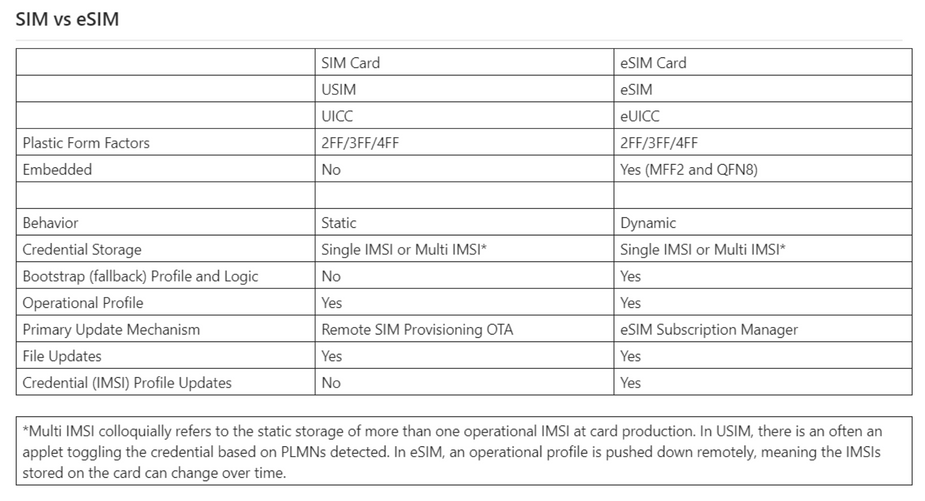Why Dynamic eUICC/eSIM Tech is Superior to Static Multi-IMSI

If you think all SIMs are built using the same technology, think again.
“IMSI” stands for International Mobile Subscriber Identities and is a unique number that lets Mobile Network Operators (MNOs) authenticate their subscribers so they can access a specific network. “Multi-IMSI” stands for Multiple International Mobile Subscriber Identities and are mainly designed for dual network and roaming applications. They are in fact physical SIMs, and even may be embedded as a faux-eSIM. Unlike traditional “single-IMSI” SIMs, static multi-IMSI’s contain multiple pre-loaded IMSIs or mobile subscriptions.
On the other hand, “eUICC” stands for Embedded Universal Integrated Circuit Card and is also known as an “eSIM”. A true eUICC lets users switch networks over-the-air (OTA) – meaning a device operator can pick its network and dynamically change identities. With eUICC tech, when a device wakes up, an operational profile can be pushed down remotely, meaning the IMSIs stored on the card can change over time and can be assigned from the cloud dynamically.
eUICC and eSIM are terms that are nearly interchangeable with one minor nuanced difference: eUICC refers to the hardware of a programmable chip either in a plastic card tray or embedded form-factor, and eSIM is a more general term describing either an embedded SIM card or the electronic network access credential information downloaded to a device (e.g. downloading an eSIM).
Differences Between Dynamic eUICCs and Static UICCs
With static multi-IMSI solutions, the two or more IMSI credentials installed at the factory are stuck there. If a device goes out of the pre-configured network’s boundaries or scope, the device operator must physically change the SIM to change the state – which, in most cases, is not possible for IoT or M2M applications and devices. On the other hand, with a true eUICC eSIM card, a device operator can dynamically change the SIM profile OTA, without needing to replace the physical SIM, simplifying operations, reducing costs, and ensuring a device is always connected.
Here are some other differences between SIM (static single or multi-IMSI UICC) and eSIM (dynamic or multi-IMSI eUICC) form factors:

Why eUICC?
eUICC technology gives a device operator the flexibility to dynamically reprogram an unlimited number of networks OTA. This technology provides flexibility, convenience, and assurance that IoT device owners are in control of their deployments and never have to worry about physically replacing SIM cards or managing multiple stock keeping units (SKUs).
For example, for an IoT device manufacturer that distributes devices globally, deploying with eUICC technology eliminates the need to create and manage multiple SKUs for each destination that a device is deployed in. Plus, loading a different SIM profile for each device based on its destination creates major complexities and costs. Having a single SKU for all of your SIM cards or eSIM hardware results in significant cost savings over time.
Last but not least, eUICC tech allows customers to go-to-market quickly and scale devices globally, eliminating the pain-staking process of:
-
Tracking where devices are going,
-
Ordering different SIM cards for each device based on its destination,
-
Physically installing the correct SIM cards in each device
The bottom-line for device makers and operators considering different SIM technologies is to be hyper-aware of companies claiming to be “eSIM” solutions, but that build their product using static multi-IMSI tech. This approach is far inferior to eUICC tech and does not give device operators the flexibility needed to manage a fleet of IoT devices across multiple geographies over the long-term.
Teal’s patented eSIM technology is built using true dynamic eUICC tech and is a “one-stop-shop” for every imaginable connectivity requirement that might arise over the lifespan of a device, including the ability to:
-
Reprogram to over 2,000+ public networks globally OTA
-
Switch between public Mobile Network Operators and Private LTE and 5G networks
-
Upgrade to new cellular technologies over time (i.e. LTE to 5G, to 6G, etc.)
-
Access communications technologies beyond cellular (satellite, LoRa, etc.)
Please visit www.tealcom.io to learn more about Teal’s eUICC-based eSIM technology.
Recent Posts
Revolutionizing Global BVLOS Drone Operations with Advanced eSIM Technology
Teal Communications Staff2024-04-03T14:24:37+00:00
Navigating the New Digital Landscape: Futureproofing Against the 3G Shutdowns in Australia and Southeast Asia
Teal Communications Staff2024-03-22T15:06:21+00:00
The Only Connectivity Choice for High-Data Use Cases: The Rising Dominance of eSIM
Teal Communications Staff2024-03-11T18:09:33+00:00




